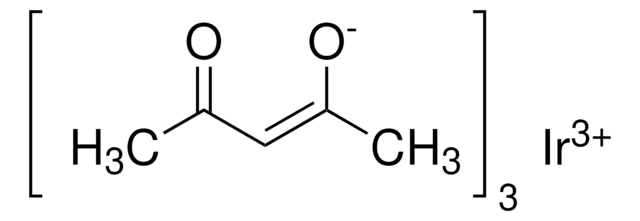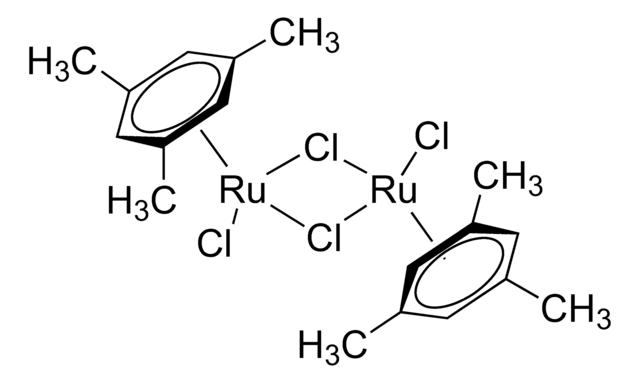추천 제품
일반 설명
Ruthenium(III) acetylacetonate is a dark violet solid that exhibits high solubility in organic solvents. It exhibits fast kinetics for oxidation and reduction, facilitating efficient electrochemical reactions. It is widely used in the field of nanomaterial synthesis, solar cells, batteries, and supercapacitors.
애플리케이션
Ruthenium(III) acetylacetonate can be used:
- As an electrolyte in redox flow batteries. It helps to enhance the voltage efficiency of batteries.
- As a starting material to synthesize homogeneously dispersed Ru nanoparticles for super capacitor applications.
- As a precursor to synthesize ruthenium single atom multifunctional electrocatalyst that exhibits outstanding catalytic performance for zinc-air battery and overall water splitting reaction.
- To fabricate Ru2P anodic catalyst for polymer electrolyte fuel cells. It helps to improve hydrogen oxidation reaction performance.
- As a reliable and stable cathode interfacial layer to significantly improve solar cell efficiency and stability.
Storage Class Code
11 - Combustible Solids
WGK
WGK 3
Flash Point (°F)
Not applicable
Flash Point (°C)
Not applicable
개인 보호 장비
dust mask type N95 (US), Eyeshields, Gloves
이미 열람한 고객
Yuxiao Zhang et al.
Chemistry, an Asian journal, 14(2), 278-285 (2018-12-07)
Molybdenum disulfide (MoS2 ) has been regarded as a favorable photocatalytic co-catalyst and efficient hydrogen evolution reaction (HER) electrocatalyst alternative to expensive noble-metals catalysts, owing to earth-abundance, proper band gap, high surface area, and fast electron transfer ability. In order
Bih-Show Lou et al.
Scientific reports, 6, 19949-19949 (2016-01-29)
The synthesis of highly dispersed and stable ruthenium nanoparticles (RuNPs; ca. 2-3 nm) on porous activated carbons derived from Moringa Oleifera fruit shells (MOC) is reported and were exploited for supercapacitor applications. The Ru/MOC composites so fabricated using the biowaste carbon
Tuenissen, H.T. Elsevier, C.J.
Chemical Communications (Cambridge, England), 667-667 (1997)
Kaipeng Liu et al.
Nature communications, 11(1), 1263-1263 (2020-03-11)
Single-atom catalysts (SACs) have demonstrated superior catalytic performance in numerous heterogeneous reactions. However, producing thermally stable SACs, especially in a simple and scalable way, remains a formidable challenge. Here, we report the synthesis of Ru SACs from commercial RuO2 powders
Ming Zhao et al.
ACS nano, 13(6), 7241-7251 (2019-05-31)
Owing to their highly open structure and a large number of low-coordination sites on the surface, noble-metal nanoframes are intriguing for catalytic applications. Here, we demonstrate the rational synthesis of Ru cuboctahedral nanoframes with enhanced catalytic performance toward hydrazine decomposition.
자사의 과학자팀은 생명 과학, 재료 과학, 화학 합성, 크로마토그래피, 분석 및 기타 많은 영역을 포함한 모든 과학 분야에 경험이 있습니다..
고객지원팀으로 연락바랍니다.









